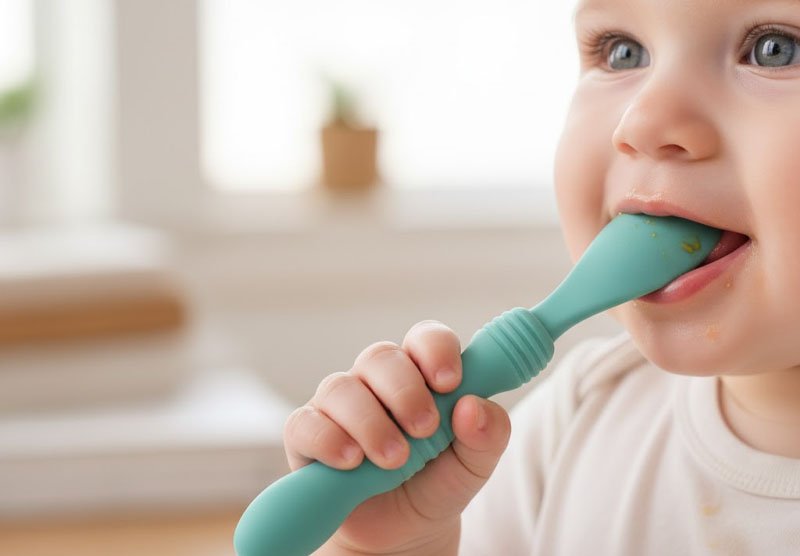Feeding time can feel like a battle—but the right spoon makes all the difference.
Ergonomic silicone spoons are designed for comfort, safety, and development. They reduce feeding stress, protect delicate gums, and support babies learning to self-feed.
Not all baby spoons are created equal. I’ve tested dozens during product development, and the right shape, size, and material can change the entire mealtime experience—for both baby and parent. Let’s look at why ergonomic silicone spoons stand out.

What makes a spoon “ergonomic”?
It’s not just about looks—ergonomics is about how the spoon feels and functions in real use.
An ergonomic spoon is designed to fit naturally in the hand, reduce strain, and allow easy control—especially for tiny, developing hands.
Designed for Real-World Use
When I first began working with silicone feeding products, one thing I learned quickly: a poorly designed spoon frustrates both the baby and the parent.
An ergonomic silicone spoon has:
- A curved or angled handle that fits naturally in the parent’s or baby’s grip
- A soft, flexible tip that’s gentle on gums
- A lightweight body for easier control
- A non-slip grip to reduce drops
These design details support comfort and control. Feeding becomes smoother, less messy, and more enjoyable.
Why is silicone better for baby spoons?
Material choice affects safety, comfort, and hygiene.
Silicone is soft, safe, and flexible—making it ideal for feeding babies without hurting gums or leaching chemicals.

Soft but Strong
I’ve worked with both plastic and metal prototypes. But none matched silicone for baby feeding. It’s soft enough to bend slightly with pressure but strong enough to hold food without collapsing.
Here’s why silicone outperforms other materials:
| Feature | Silicone | Plastic | Metal |
|---|---|---|---|
| Gum Safety | ✅ Soft and flexible | ⚠️ Can be rigid | ❌ Too hard |
| Heat Resistance | ✅ Very high | ⚠️ Limited | ✅ High |
| Chemical Safety | ✅ BPA-free & inert | ⚠️ Depends on type | ✅ Safe |
| Cleaning Ease | ✅ Dishwasher safe | ✅ Usually | ✅ Usually |
Silicone spoons won’t chip, warp, or crack. That means fewer replacements—and more peace of mind.
How do ergonomic silicone spoons help with self-feeding?
At some point, every baby wants to try feeding themselves.
Ergonomic silicone spoons are designed to support self-feeding by making it easier for babies to hold, scoop, and guide food to their mouths.

Building Confidence, One Scoop at a Time
I’ve observed babies try to feed themselves with regular spoons—and the results are often messy and frustrating. The spoon is too long, too heavy, or too slippery. But ergonomic silicone spoons solve that.
Here’s how they help:
- Shorter handles fit small hands better
- Thicker grips are easier to hold
- Shallow, soft heads make scooping and mouth entry easier
- Curved necks align naturally with baby’s wrist movement
Self-feeding is key for building independence, motor skills, and coordination. The right spoon doesn’t just make meals easier—it supports development.
Are ergonomic silicone spoons safer than other options?
Feeding tools shouldn’t just be convenient—they should be safe.
Ergonomic silicone spoons reduce the risk of injury thanks to their soft tips, rounded edges, and flexible design.

Safety in Every Bite
Safety is non-negotiable when it comes to baby products. I’ve rejected many designs over the years simply because they had sharp edges or stiff tips.
Silicone’s softness reduces risk during:
- Teething: Babies often chew on spoons—silicone won’t hurt their gums.
- Feeding struggles: A slip with a hard spoon can jab a baby’s mouth.
- Exploration: Babies like to play with their tools—soft materials are safer.
With ergonomic shapes and flexible materials, silicone spoons offer protection during all these moments.
Do these spoons make feeding easier for parents?
Parents need tools that work for them—not just for the baby.
Ergonomic silicone spoons improve grip, reduce spills, and make feeding less stressful for parents.
Comfort for the Feeder, Too
Many ergonomic spoons are not just for babies—they’re designed with adults in mind, too. Whether you’re a mom spooning oatmeal at 6am or a dad holding a wiggly baby at dinner, comfort matters.
Features parents love:
- Angled handles reduce wrist strain
- Wide, non-slip grips for better control
- Soft tips that slide food off smoothly
- Lightweight design for one-handed use
Feeding is repetitive. A spoon that’s comfortable for you improves consistency—and reduces frustration.
What are the long-term benefits of using ergonomic silicone spoons?
Every small decision builds a foundation for healthier habits.
Using the right spoons from the beginning supports safer feeding, better development, and longer-lasting tools that grow with your child.

Investing in Healthy Mealtimes
I’ve seen how the right tools shape routines. When a spoon feels good, feeding feels easier. When babies feel in control, they enjoy mealtimes more. When a product lasts through toddlerhood, you save money and reduce waste.
Key benefits:
- Fewer spoon replacements
- Better feeding routines
- Improved motor skills and independence
- Lower risk of oral injuries
The impact of ergonomic silicone spoons goes far beyond one meal. They help create healthy, confident eaters—and more relaxed parents.
Conclusion
Ergonomic silicone spoons are a smart, safe, and supportive choice for both babies and parents. Designed for comfort and development, they turn every bite into a better experience.